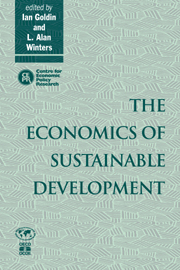Book contents
- Frontmatter
- Contents
- List of figures
- List of tables
- Preface
- Acknowledgements
- List of conference participants
- 1 Economic policies for sustainable development
- PART ONE GROWTH AND THE ENVIRONMENT
- PART TWO SUSTAINABILITY
- PART THREE DOMESTIC POLICY
- PART FOUR INTERNATIONAL POLICY COORDINATION
- 9 Carbon abatement, transfers and energy efficiency
- 10 Policy coordination for sustainability: commitments, transfers, and linked negotiations
- Discussion
- 11 Industrial competitiveness, environmental regulation and direct foreign investment
- Discussion
- Index
9 - Carbon abatement, transfers and energy efficiency
Published online by Cambridge University Press: 04 August 2010
- Frontmatter
- Contents
- List of figures
- List of tables
- Preface
- Acknowledgements
- List of conference participants
- 1 Economic policies for sustainable development
- PART ONE GROWTH AND THE ENVIRONMENT
- PART TWO SUSTAINABILITY
- PART THREE DOMESTIC POLICY
- PART FOUR INTERNATIONAL POLICY COORDINATION
- 9 Carbon abatement, transfers and energy efficiency
- 10 Policy coordination for sustainability: commitments, transfers, and linked negotiations
- Discussion
- 11 Industrial competitiveness, environmental regulation and direct foreign investment
- Discussion
- Index
Summary
Introduction
The concept of ‘sustainable growth’ is rather fuzzy but, as many of the chapters in this volume have emphasised, it involves a concern with the earth's environmental resources. The earth's atmosphere is one important example of such a resource. In recent years, there has been a growing awareness of the potential threat to the atmosphere posed by global warming. The phenomenon of global warming is associated with the accumulation in the atmosphere of so-called ‘greenhouse gases’, of which carbon dioxide (CO2) is the most important man-made gas. While there is great uncertainty about the likelihood of global warming, the risk is now being taken seriously, as evidenced by the fact that many OECD countries are promulgating targets for curbing their emissions of greenhouse gases, with a particular focus on CO2.
Previous work with the OECD GREEN model has shown that an international agreement involving all the major CO2 emitting countries is necessary to tackle the problem of climate change. However, devising an international agreement and developing strategies for its implementation and enforcement are likely to prove daunting tasks. For example, it would be highly desirable for any agreement to be cost-effective. But in order for any agreement to be cost-effective, CO2 abatement must be undertaken by both OECD and nonOECD countries, with the largest burden being borne by the coal intensive low income lesser developed countries (LDCs) such as China and India (see chapter 8 in this volume). Thus, a key question for policy makers is: how can one design a cost-effective and equitable international agreement which could commit all the key CO2 emitting countries to curb their emissions?
- Type
- Chapter
- Information
- The Economics of Sustainable Development , pp. 239 - 263Publisher: Cambridge University PressPrint publication year: 1995
- 1
- Cited by



